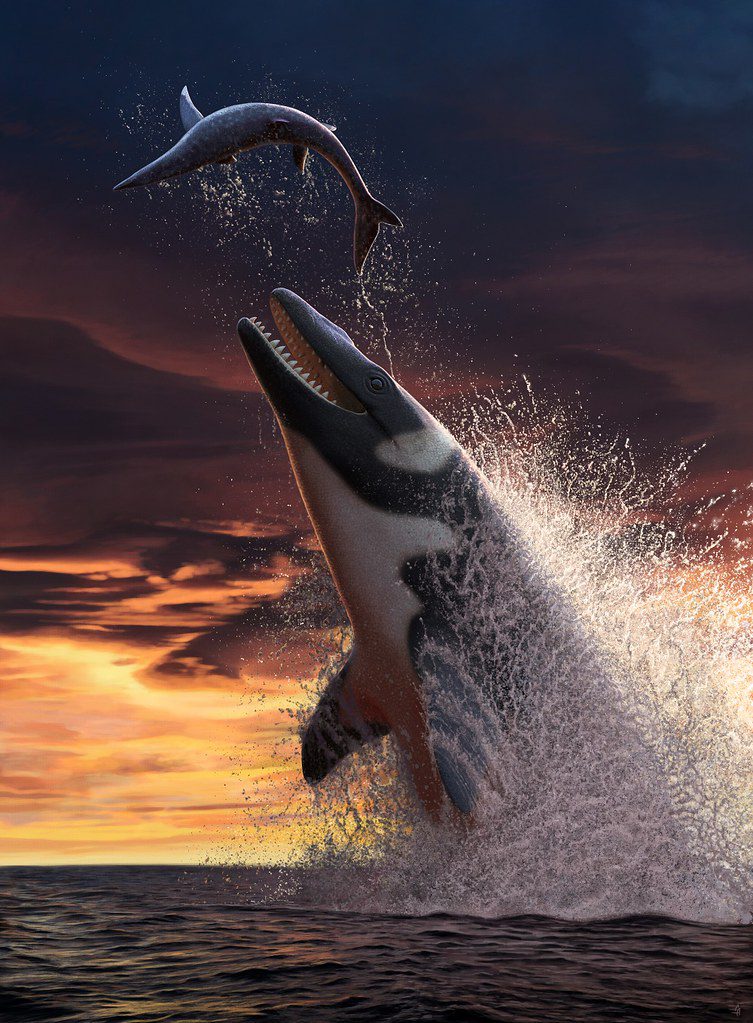It was the size of a killer whale, with the mouth and teeth to match; it had a tail similar to that of a shark, and a body like a Komodo dragon. It sounds like a ferocious chimera from myths of old – and in a way, it is. But in a much more scientifically accurate and awesome way, it’s actually a newly discovered sea monster from 66 million years ago – and it’s called Thalassotitan atrox.
“Thalassotitan was an amazing, terrifying animal,” said Nick Longrich, Senior Lecturer from the Milner Centre for Evolution at the University of Bath, in a statement. He’s the lead author of a study, published Wednesday in the journal Cretaceous Research, presenting the discovery of the new prehistoric titan.
Technically, it’s not a dinosaur, but a mosasaur: a giant marine reptile distantly related to today’s iguanas and monitor lizards. Unlike today’s iguanas and monitor lizards, however, they could grow up to 12 meters (40 feet) in length. In fact, the new discovery is nearly nine meters (30 feet) long, with an enormous skull measuring 1.4 meters (5 feet) of that. It lived on a steady diet of everything from small fish to sea turtles and other huge marine reptiles.
We know that, in part, because some of the beast’s victims may have been found alongside its fossilized remains. In the same bed, the researchers found large fossils of large predatory fish, a sea turtle, the half-meter long head of an elasmosaur – a type of plesiosaur that looks like a cross between a brachiosaurus and a turtle – and jaws and skulls of at least three different mosasaur species. They were damaged by acid – potentially the Thalassotitan’s stomach acid
“It’s circumstantial evidence,” said Longrich. “We can’t say for certain which species of animal ate all these other mosasaurs.”
“But we have the bones of marine reptiles killed and eaten by a large predator,” he added. “And in the same location, we find Thalassotitan, a species that fits the profile of the killer – it’s a mosasaur specialized to prey on other marine reptiles. That’s probably not a coincidence.”

Artist’s impression of a Thalassotitan atrox eating a sea beastie. Image Credit: Longreach et al, 2022
It seems even other Thalassotitans weren’t safe from these gargantuan predators. All mosasaurs tend to be found with evidence of violent injuries to their faces and jaws – war wounds from fighting over feeding grounds or mates – but Thalassotitan seems to have been extra bellicose, with injuries described as “exceptionally common” and intense.
The discovery speaks to the incredible diversity of Cretaceous-era Africa – Thalassotitan was found in Morocco, a country already known for the most diverse mosasaur fauna in the world.
“It’s possible around 20 to 25, or even 30 species existed here,” Longrich wrote in a blog post on the discovery. “That might sound like a lot, but consider that there are 26 cetaceans living off the coast of Morocco today. Why not a similar number of mosasaurs?”
However, it’s also a clue to a question that’s long been the subject of debate in paleontological circles – what was going on before that fateful asteroid hit?
See, 66 million years ago lines up very well with the Cretaceous-Paleogene (K-Pg) extinction event, the meteorite strike which saw about three out of every four species suddenly become instinct – with very few exceptions, literally no tetrapods weighing over 25 kilograms (55 pounds) survived.
So devastating was this event that some scholars have suggested that biodiversity on Earth was already winding down before the End – species were becoming ultra-niche and stagnant, and so they couldn’t cope with any sudden disruption to their ecosystem. The asteroid was the final blow, sure – but in a different time, or under different circumstances, the impact wouldn’t have been so final.
However, Thalassotitan “emphasizes just how diverse the mosasaurs were,” Longrich wrote. It suggests the existence of “a highly diverse, functional ecosystem that was literally in a matter of weeks and months destroyed by a single, catastrophic, completely unpredictable event.”
“This perspective on evolution is terrifying,” he added. “We’d like to think there’s some order and predictability to life. This […] scenario suggests that, no, it’s not predictable. There’s no order. Everything could be going well and you could be wiped off the face of the earth entirely, as if you’d been struck by lightning out of the blue (or hit by an asteroid). S*** happens.”
Source Link: Newly-Discovered Cretaceous Mega Predator Comes With Free Existential Crisis